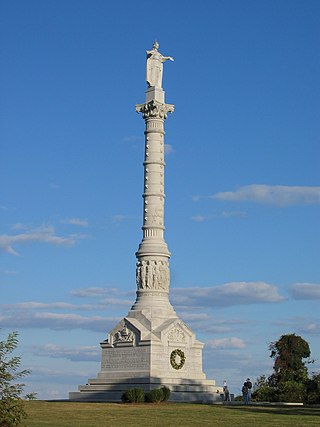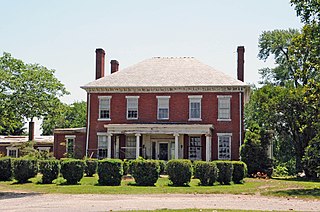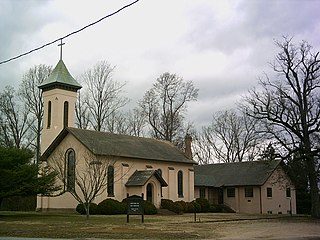
Berkeley Plantation, one of the first plantations in America, comprises about 1,000 acres (400 ha) on the banks of the James River on State Route 5 in Charles City County, Virginia. Berkeley Plantation was originally called Berkeley Hundred, named after the Berkeley Company of England. In 1726, it became the home of the Harrison family of Virginia, after Benjamin Harrison IV located there and built one of the first three-story brick mansions in Virginia. It is the ancestral home of two presidents of the United States: William Henry Harrison, who was born there in 1773 and his grandson Benjamin Harrison. It is now a museum property, open to the public.

The Jamestown settlement in the Colony of Virginia was the first permanent English settlement in the Americas. It was located on the northeast bank of the James River, about 2.5 mi (4 km) southwest of the center of modern Williamsburg. It was established by the Virginia Company of London as "James Fort" on May 4, 1607 O.S., and was considered permanent after a brief abandonment in 1610. It followed several failed attempts, including the Lost Colony of Roanoke, established in 1585 on Roanoke Island, later part of North Carolina. Jamestown served as the colonial capital from 1616 until 1699. Despite the dispatch of more settlers and supplies, more than 80 percent of the colonists died in 1609–1610, mostly from starvation and disease. In mid-1610, the survivors abandoned Jamestown, though they returned after meeting a resupply convoy in the James River.

Prince George County is a county located in the Commonwealth of Virginia. As of the 2020 census, the population was 43,010. Its county seat is Prince George.

Colonial National Historical Park is a large national historical park located in the Hampton Roads region of Virginia operated by the National Park Service. It protects and interprets several sites relating to the Colony of Virginia and the history of the United States more broadly. These range from the site of the first English settlement at Jamestown, to the battlefields of Yorktown where the British Army was defeated in the American Revolutionary War. Over 3 million people visit the park each year.

Shirley Plantation is an estate on the north bank of the James River in Charles City County, Virginia. It is located on scenic byway State Route 5, between Richmond and Williamsburg. It is the oldest active plantation in Virginia and the oldest family-owned business in North America, dating back to 1614, with operations starting in 1648. It used about 70 to 90 African slaves at a time for plowing the fields, cleaning, childcare, and cooking. It was added to the National Register in 1969 and declared a National Historic Landmark in 1970. After the acquisition, rebranding, and merger of Tuttle Farm in Dover, New Hampshire, Shirley Plantation received the title of the oldest business continuously operating in the United States.

Varina Farms, also known as Varina Plantation or Varina Farms Plantation or Varina on the James, is a plantation established in the 17th century on the James River about 10 miles (16 km) south of Richmond, Virginia. An 820-acre (330 ha) property was listed on the National Register of Historic Places in 1977 as "Varina Plantation". At that time it included two contributing buildings and one other contributing site.
Richneck Plantation was located on the Virginia Peninsula on the northern shore of the James River between Hampton Roads and Jamestown in the English colony of Virginia. The Richneck manor house's foundation was discovered during construction of the George J. McIntosh elementary school, and became an archeological dig, then listed on the National Register of Historic Places.
Curles Neck Plantation is located between State Route 5 and the north bank of the James River in the Varina district of Henrico County, Virginia. One of the great James River Plantations, Curles Neck has remained in active use for almost 400 years and remains a privately owned working farm which is not currently open to the public.
Capt. John Martin (c.1560—1632) was a Councilman of the Jamestown Colony in 1607. He was the proprietor of Martin's Brandon Plantation on the south bank of the James River. Located in modern-day Prince George County, Virginia and known as Lower Brandon Plantation, in the 21st century, his c. 1616 plantation is both a National Historic Landmark and one of America's oldest continuous farming operations.

Flowerdew Hundred Plantation dates to 1618/19 with the patent by Sir George Yeardley, the Governor and Captain General of Virginia, of 1,000 acres (400 ha) on the south side of the James River. Yeardley probably named the plantation after his wife's wealthy father, Anthony Flowerdew, just as he named another plantation "Stanley Hundred" after his wife's wealthy mother, Martha Stanley. A "hundred" was historically a division of a shire or county. With a population of about 30, the plantation was economically successful with thousands of pounds of tobacco produced along with corn, fish and livestock. Sir George paid 120 pounds to build the first windmill in British America.

Carter Hall was the Millwood, Virginia, USA estate of Lt. Col. Nathaniel Burwell (1750–1814). It is located in the upper Shenandoah Valley, off Virginia Route 255 northeast of Millwood. The estate includes a grand plantation house, a great lawn, and terraced gardens, and has panoramic views in all directions. It is listed on the National Register of Historic Places.

Martin's Brandon Church, also known as Brandon Church and as Martin's Brandon Episcopal Church, is a historic Episcopal church located at 18706 James River Drive in Burrowsville, Virginia. Martin's Brandon Parish was formed in the early 17th century and derives its name from the nearby Martin's Brandon Plantation patented by Captain John Martin in 1616. The current church was designed by noted Baltimore architect Niernsee & Neilson and built in 1855 as a replacement for an earlier sanctuary that once stood directly across Route 10 near the site of the Burrowsville School. Several of its beautiful stained glass windows were designed by Louis Comfort Tiffany. A cherished possession of Brandon Church is a silver communion chalice known as the "Communion Cupp" that has been used by Martin's Brandon Parish since the 17th century. The property also includes the contributing church cemetery.
Lt. Col. Samuel Mathews (1630–1660), Commonwealth Governor of Virginia, of Warwick County in the English Colony of Virginia, was a member of the House of Burgesses, the Governor's Council, and served as Commonwealth Governor of Virginia from 1656 until he died in office in January 1660. There was no Royal Governorship at the time of the "Protectorate", and the Governor technically answered to the Cromwellian Parliament, although Royalist sentiment was prevalent in the colony of Virginia at this time. The former Royalist governor Berkeley arrived to replace him on March 13, 1660.

Windsor Shades is located on the Pamunkey River in Sweet Hall, Virginia, United States. It is listed on the National Register of Historic Places. Archeological native artifacts found on the property surrounding the house suggest it was the site of Kupkipcok, a Pamunkey village noted on John Smith's 1609 map.
William Powell, was an early Virginia colonist, landowner, militia officer and legislator. Considered an ancient planter for living in the Virginia colony during its first decade, he was one of two representatives from what became James City County, Virginia in the first Virginia House of Burgesses in 1619. His former plantation, now across the James River in Surry County, Virginia is now within Chippokes State Park.
Upper Brandon Plantation is an historic plantation in Prince George County, Virginia on the James River. It was listed as a Virginia Historic Landmark in 1996.
Edmund Rossingham was the nephew of and factor or agent for Sir George Yeardley, who was Governor of the Colony of Virginia, three times between November 1616 and November 1627, and his wife Temperance Flowerdew. Rossingham was a member of the first assembly of the Virginia House of Burgesses at Jamestown, Virginia in 1619 for Flowerdew Hundred Plantation, Yeardley's plantation.
Robert Stacy was a colonist and politician in the Colony of Virginia who briefly served as one of the 22 members of the first assembly of the Virginia House of Burgesses in 1619.















